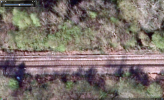norbitonflyer
Established Member
Notably on the AM£s - the Glasgow Blue Trains had to be substitiuted by steam for a few weeks until the problem was rectified (oh, dear - pun not intended)They did originally use mercury-arc rectifiers, but the rectifiers were inclined to backfire, which damaged the transformers and led to fires and explosions. So it's not surprising that they switched to solid-state as soon as they could.
I think there were expolsions in other units as well. As the rectifiers were in a cubicle adjacent the guard's compartment, the NUR had some strong words with BR on the subject.

